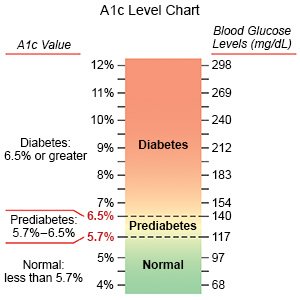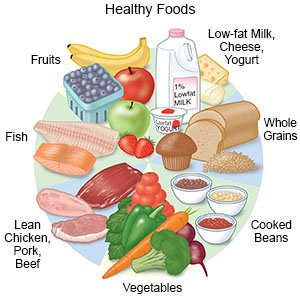Prediabetes
Medically reviewed by Drugs.com. Last updated on Aug 4, 2025.
What is prediabetes?
Prediabetes is a blood glucose (sugar) level that is higher than normal. It is not high enough to be considered diabetes. Prediabetes increases your risk for type 2 diabetes and heart disease. The risk is highest if you have high blood pressure or high cholesterol.
What increases my risk for prediabetes?
- Excess body weight or obesity
- Lack of physical activity
- Older age
- Family history of diabetes (parent or sibling)
- A history of heart disease, gestational diabetes, or polycystic ovary syndrome (PCOS)
- High blood pressure or cholesterol levels
- Having African American, Latino, Native American, Asian American, or Pacific Islander heritage
- In children, having a mother with diabetes or gestational diabetes mellitus (GDM) during the pregnancy
- Certain medicines such as steroids, antipsychotics, and medicines used to treat HIV infection
What are the signs and symptoms of prediabetes?
Prediabetes may not cause any symptoms.
How is prediabetes diagnosed?
Blood tests can help diagnose prediabetes even if no signs or symptoms have started. This is also called screening. Screening for all adults can start at age 35. Your healthcare provider may recommend screening at an earlier or later age. This will depend on your overall risk for diabetes. Adults who have excess body weight or obesity, and risk factors, are usually tested every 3 years. You may be tested sooner if you have symptoms or your risk for diabetes increases. Children who are at risk for diabetes may be tested. The following may be used to diagnose prediabetes:
- A fasting plasma glucose test may be done to check your blood sugar level after you have not eaten for 8 hours.
- A 2-hour plasma glucose test starts with a blood sugar level check after you have not eaten for 8 hours. You are then given a glucose drink. Your blood sugar level is checked after 2 hours.
- A hemoglobin A1c is a blood test that measures your average blood sugar level for the past 2 to 3 months. An A1c of 5.7% to 6.4% means you have prediabetes.

How do I prevent or delay type 2 diabetes?
Healthy choices work best to delay or prevent type 2 diabetes. You may be given the following guidelines from your healthcare provider:
- Get regular physical activity. Adults should get at least 150 minutes (2.5 hours) of moderate physical activity every week. Spread the amount of activity over at least 3 days a week. Do not skip more than 2 days in a row. Children should get at least 60 minutes of moderate physical activity on most days of the week. Examples of moderate physical activity include brisk walking, running, and swimming. Do not sit for longer than 30 minutes at a time. Work with your healthcare provider to create a plan for physical activity.

- Maintain a healthy body weight. Your healthcare provider can tell you what a healthy weight is for you. Your provider can help you create a weight-loss plan, if needed. Even a weight loss of 3% to 7% of excess body weight can be helpful.
- Eat a variety of healthy foods. Examples include vegetables, fruit, whole-grains, low-fat dairy, healthy fats, fish, and lean meat or protein foods. Eat fewer sweets, such as candy, cookies, regular soda, and sweetened drinks. You can also decrease calories by eating smaller portion sizes. Work with your healthcare provider or dietitian to develop a meal plan that is right for you.

- Take medicine as directed. Your healthcare provider may give diabetes medicine if you are at high risk for diabetes. You may also need medicines for high blood pressure, high cholesterol, or to help manage your weight.
- Get 8 to 10 hours of sleep each night. Getting enough sleep may help your body use insulin better, regulate your appetite, and control your weight. Create a sleep schedule. Go to bed and wake up at the same time each day. It may be helpful to listen to music or read before bed. Do not have drinks that have caffeine or watch television right before bed.
- Follow up with your healthcare provider as directed. You will need to return every year to get tested for diabetes, if you have prediabetes. Your provider may also recommend counseling to help you make food or physical activity changes.
- Do not smoke. Do not use e-cigarettes or smokeless tobacco in place of cigarettes or to help you quit. They still contain nicotine. Ask your healthcare provider for information if you currently smoke and need help quitting.
- Start with small goals and work your way up. For example, a goal may be to get 3 days of physical activity each week. You can add a day after 3 weeks or so of activity. A goal may also be safe and steady weight loss. Examples are losing 1 to 2 pounds each week or focusing on losing 5 pounds at a time. A smartphone application (app) can track healthcare information to help you reach your goals. You can use an app as a tool to help prevent diabetes. Ask your provider which app is best for you.
When should I call my doctor?
- You have more hunger or thirst than usual.
- You are urinating more often than usual.
- You are more physically and mentally tired than usual.
- You have blurred vision.
- You have questions or concerns about your condition or care.
Care Agreement
You have the right to help plan your care. Learn about your health condition and how it may be treated. Discuss treatment options with your healthcare providers to decide what care you want to receive. You always have the right to refuse treatment. The above information is an educational aid only. It is not intended as medical advice for individual conditions or treatments. Talk to your doctor, nurse or pharmacist before following any medical regimen to see if it is safe and effective for you.© Copyright Merative 2025 Information is for End User's use only and may not be sold, redistributed or otherwise used for commercial purposes.
Learn more about Prediabetes
Treatment options
Care guides
Further information
Always consult your healthcare provider to ensure the information displayed on this page applies to your personal circumstances.
